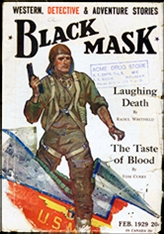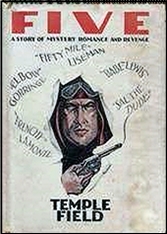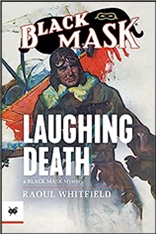REVIEWED BY DAVID VINEYARD:

RAOUL WHITFIELD – Laughing Gas. Steeger Books. paperback, 2021. Originally serialized in Black Mask, February 1929 to October 1929. Revised and reprinted in book form as Five, by Temple Field.
In his introduction to the Steeger reprint, James Reasoner uses the term “word savagery” which was coined by Lester Dent to describe the quality Black Mask brought out in writers, and that certainly fits Raoul Whitfield though I prefer the Raymond Chandler’s term ‘the poetry of violence.” Anyway you put it, Raoul Whitfield was a master of the form, the third spoke of the wheel that included Hammett and Chandler as the best Black Mask has to offer.
Laughing Gas was Whitfield’s first attempt at a novel length work, written as a series of tightly connected short stories and intended to be published as a fix-up novel. It ended up replaced by another Whitfield serial, Green Ice, that would become Whitfield’s first novel (and wisely, it is a better book) while Laughing Gas was rewritten and published as Five, under the by-line Temple Field. This trade paperback edition from Steeger Books Black Mask collection is the works first appearance in its original form since its publication in the 1929 pages of Black Mask.

The book covers nine stories. Gary Greer, the two-fisted protagonist, sets out to avenge the murder of his Prosecutor father Stanford by gangsters who laughed while he died at their brutal hands. Greer, a pilot in charge of the local airport, sets out for revenge, and neither the law nor criminals are going to deter him in his singular minded pursuit.
This is Mike Hammer country, a revenge story much like Whitfield’s similar Green Ice and savage is a fair description of what happens as Greer tracks down the five men who killed his father.
There was a distant rumble of thunder. Gary Greer stood motionlessly, listening, waiting. Then he moved slowly toward the rear of the narrow hallway. Ten yards —- and he stopped again. His ears picked up a faint sound of a groan. His right hand touched steel inside he pocket. He moved on.
Another groan —- a sharp hissing of breath. Then a pounding — a sound like the beating of fists on a floor. From below came a lilt of drunken song. A bottle crashed. Thunder rumbled again. There was a deep toned note, distant and sustained, of a riverboat. A big boat…
Greer drew his Colt from his pocket.

Whitfield wrote as much or more aviation fiction as crime novels including several juvenile aviation novels. This one mixes the two genres, flying and hardboiled action and does so in a convincing tough guy voice that compels the narrative along like an express train.
It is a far pulpier work than his best hardboiled novel, Death in a Bowl, a work that comes close to rivaling Hammett’s Maltese Falcon, but it reads surprisingly modern in style, another Mask attribute. The dark salon cars speeding down roads, vintage planes, and Tommy guns may be dated, but the writing is as contemporary as anything you’ll read today.
A chance. No, he had given Lewis little chance. But he had looked into the gangster’s eyes. He had seen the eyes of one of his father’s killer. One.
In addition to revenge intrigue and murder there is a well handled romance that leads you to wonder how Hollywood missed this one. Of course they would have had to tone it down a bit because Greer is a fairly grim avenger adopting multiple identities, names, and faces as he takes his revenge on hoods with colorful names like Frenchy Lamotte, Doll Jacobs, Sal the Dude, and “Fifty Mile” Liseman.
Whitfield just misses the quality that set Hammett and Chandler apart from the pack, and it is hard to define exactly what it is. It may be because he never quite finds that single voice protagonist (though Death in a Bowl comes close and Jo Gar is a fine creation) or spread himself too thin with his other pulp work. I can’t say exactly. I know at his best he writes as well as either Hammett or Chandler with that same word savagery Reasoner mentions, but he also writes with just the slightest bit less conviction and dedication.
Granted there is a fairly contrived twist at the end that allows for a happy ending, but it’s the pulps and the kind of thing common in movies at the time, and I can’t bring myself to complain much. After all that an unconvincing path to a happy ending seems a small price to pay. You wouldn’t want Whitfield’s protagonist taking revenge on you because you messed with his happy ending, believe me.
Just let him have it and lump it.























